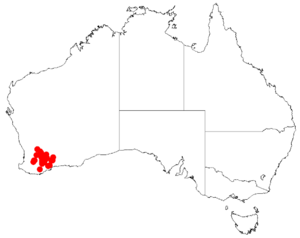Acacia brachyphylla facts for kids
Quick facts for kids Acacia brachyphylla |
|
|---|---|
| Scientific classification | |
| Genus: |
Acacia
|
| Species: |
brachyphylla
|
 |
|
| Occurrence data from AVH | |
Acacia brachyphylla is a special kind of shrub that belongs to the Acacia family, also known as wattles. It's a plant that grows naturally only in a small part of southwestern Australia. This means it's "endemic" to that area, found nowhere else in the world!
Description
This spreading shrub usually grows to be about 0.2 to 0.3 meters (or about 8 to 12 inches) tall. Its small branches are covered in tiny hairs and are round. They also have small, triangular leaf-like parts called stipules, which are about 1.5 millimeters long.
Like most Acacia plants, it has "phyllodes" instead of true leaves. Phyllodes are flattened leaf stalks that look and act like leaves. These green phyllodes grow upwards and can be straight or slightly curved. They are usually 3 to 12 millimeters long and about 1 millimeter wide. Each phyllode has six to eight tiny, hairy veins.
The plant blooms from August to October, showing off its yellow flowers. Its simple flower clusters grow alone or in pairs. Each flower cluster forms a round ball, about 3 to 4 millimeters across, with 8 to 12 golden flowers.
After the flowers, the plant grows thin, paper-like seed pods. These pods are long and narrow, up to 5 centimeters long and 1.5 to 4.5 millimeters wide. They can be hairy, smooth, or covered in a fine white powder. The seeds inside are mottled brown to grey-brown, broadly oval, and about 2 to 2.5 millimeters long.
Taxonomy
"Taxonomy" is how scientists classify and name living things. For Acacia brachyphylla, there are two main types, or varieties, that scientists recognize:
- Acacia brachyphylla var. brachyphylla
- Acacia brachyphylla var. recurvata
Distribution
This plant is native to a specific area in the Wheatbelt and Great Southern regions of Western Australia. It often grows on sandy plains in gravelly and sandy loam soils. You can find this plant from around Tammin in the northwest to Jerramungup in the southeast.

